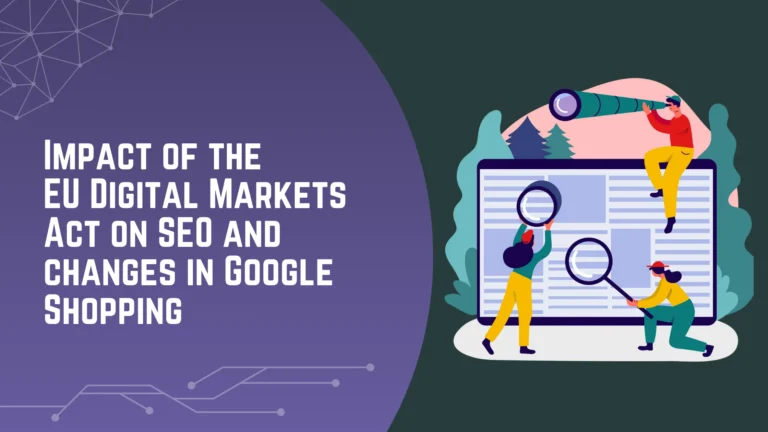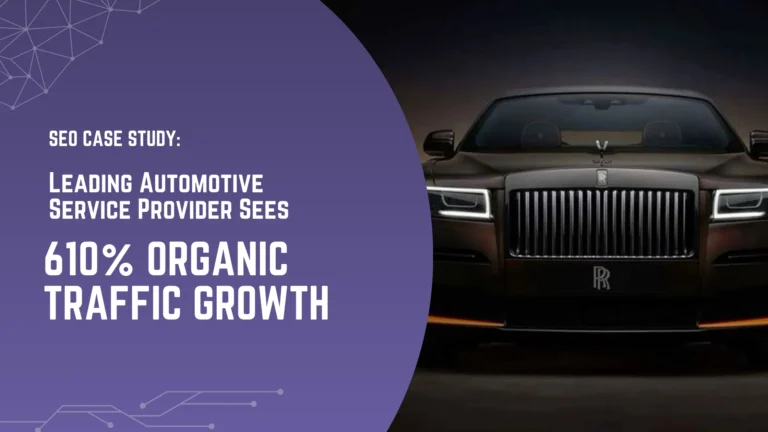If you want to sell your products and services on e-commerce websites and wish to reach out to the largest audience possible, you need to have an appealing website which is adequately optimised. There are many advantages of having a good SEO for e-commerce website, such as time efficiency and global reach. Accessing a bigger market and potentially impacting more people with your business becomes much easier when your website is optimized with e-commerce seo parameters.
Owning an e-commerce website provides business owners with the opportunity to leverage the substantial expansion of the industry. This approach serves as an excellent means to widen market reach and connect with a significantly larger customer base.
As per reports it is estimated that 95% of purchases will be made online by 2040. The industry is expected to reach an astonishing $8 trillion by 2026.
E-commerce transactions are increasing, yet many businesses need help to reach their full potential in acquiring customers. Ranking highly in SERPs is vital to gaining more e-commerce sales, but there’s no easy way.
With proper seo strategies for e-commerce website, it can be easier to stand out from the competition and gain visibility in a saturated market. It would be best to have an SEO strategy to compete with more prominent companies and break into unknown markets.
With this guide, discover how seo in ecommerce works to boost your online sales and learn how to optimise your content for maximum visibility & get ahead of the competition with proven strategies & tactics for success!
The Fundamentals of E-commerce SEO
For ecommerce businesses to improve their visibility and ranking in search engine results, e-commerce SEO is a potent tool. To maximise their ROI and outperform the competition, companies must comprehend the fundamentals of e-commerce SEO.
E-Commerce SEO assists businesses in reaching out to new clients, boosting traffic, and growing sales through keyword research, optimization, link building, and content marketing. To put seo strategies brands requires more than adding relevant keywords and writing contents. To succeed, you need to thoroughly know how search engines work and which optimization strategies they reward.
When a user performs an online search, they try to achieve something specific by, known as keyword intent. By examining what phrases people input into Google and the outcomes generated from those searches, you can learn more about a particular query’s meaning and intent of the user.
Long-tail keywords are the best search terms that can give you insights into your customer’s intent and what they’re searching for. Knowing this will allow you to create more effective marketing campaigns and strategies. For instance, short-tail keywords like “shoes” can be helpful, but long-tail ones like “best shoes for monsoons” provide more insight into customers’ motives and trajectories.
They can be accommodating when it comes to predicting their next steps. Employing on-page optimization techniques can attract new customers, acquire more conversions, and successfully reach your business goals. It’s wise to focus your efforts on the most essential areas of the e-commerce website.
You can incorporate high-resolution, unique images to enhance product descriptions and make them more effective. This will help create a better user experience and encourage more conversions. Adding Calls-to-Action can be beneficial in driving conversions and increasing customer engagement. Testimonials are also a great way to increase trust, credibility, and brand loyalty.

8 Actionable Tips for E-commerce SEO to boost your store sales
It’s essential to have an effective SEO strategy in place to maximise your chances of success. Here we have some actionable tips for e-commerce SEO that will help you get the most out of your efforts:
1. Conducting Targeted Keyword Research–
During keyword research, make sure not to look only at the most popular terms related to your industry. Try to include fewer common long keywords that offer more targeted results. Considering buyer intent is necessary for businesses looking to create compelling content. Use Long-tail keywords. Long-tail keywords are phrases or words with a low search count but are still highly relevant to your business.
Targeting specific keywords and phrases can be a great way to increase your website’s visibility. It is more likely to result in higher search rankings, producing more organic traffic than general terms.
Additionally, the relevance of these search terms usually ensures improved conversion rates. Buyer intent is likewise related to these searches. There are two main types of keyword intent:
- Informational keyword intent: People often search for more information on a specific topic using questions like “How do I?” or factual queries. In such cases, they are craving to learn more and better understand the concept.
- Commercial keyword intent: When a person knows what they are searching for but does not know where to look, these searches come into play. People searching for products and services often use specific phrases, like ‘buy a smartphone’ or ‘find USA hotel deals’. This indicates a more substantial possibility of them wanting to purchase something. As a result, commercial keywords are seen as more valuable.
To understand the intent behind a keyword, there are several approaches you could take – one being Google’s keyword planner, SEMrush or Ahrefs. This is a great way to determine what people are searching for and how best to use those words in your content.
If you want to know what people are searching for, “Answer the Public” is a great resource for you to use. All you have to do is type in your keyword, and it will give you all kinds of questions that people are asking on the internet related to that search term. This tool can provide valuable insights into people’s questions about your topic.
2. Optimising Product Pages–
Your e-commerce store can attract new customers and increase conversions with proper on-page optimization techniques. It is vital to target the essential parts of the website to make a significant impact.
Before optimising your product descriptions, take three steps back and ask yourself: What details can I use that will truly make a difference to the efficiency of my product descriptions? How can this information be used to upgrade the effectiveness of the product descriptions ultimately?
To enhance the impact of your product pages, you can include numerous optimization techniques like adding stunning visuals, utilising relevant keywords, including detailed and keyword-rich meta descriptions, using effective Calls to Action (CTAs) and incorporating customer reviews and testimonials to back up what you are offering.
High-quality product images will help visitors better understand what they are purchasing. Enhancing your images for SEO will make it easier for search engines to find them, resulting in higher rankings and more website traffic from potential customers. Social media channels can also aid in driving more traffic to your site.
To get the most out of your images, select compatible visuals and appropriate dimensions. Additionally, utilising captioning with ALT tags is also recommended for maximum optimization. Reviews are essential for e-commerce to be successful. They play a pivotal role in helping customers make informed decisions when buying products from online stores.
Ratings and reviews from customers can lead to more trust in your business, which translates to higher conversion rates. Having reviews also gives people an idea of what other clients have experienced with your services or products. It is a great way to encourage customer engagement and build brand loyalty.
3. Enhancing Site Structure and Navigation–
An organised URL structure leads to a better user experience and can significantly boost your e-commerce SEO performance. It also supports SEO efforts since search engines can utilise more relevant information. It streamlines the process of sharing products on social media and other websites, simplifying the process.
URLs should be concise and understandable so that they are easy to remember. Keeping them as brief as possible is ideal for maximum efficiency. An excellent example of a URL looks like this- https://www.example.com/baking-articles/. Furthermore, having an uncomplicated URL structure for your e-commerce site simplifies sharing products on social media and other websites.
To achieve maximum effectiveness, URLs should be as easily readable as possible. The user experience should be the number one priority; however, keywords can also be added to create an optimal URL. This ensures the best possible outcome for your website visitors.
Breadcrumbs are an excellent feature for any website, as they allow visitors to easily navigate between different pages and return to the main page without much effort. This makes exploring a website convenient and hassle-free. Breadcrumbs are not only helpful in terms of usability, but they also offer essential SEO advantages.
If you look at a blog post from the homepage, its breadcrumb trail would be something like “Home > Blog > This Post”. This helps to provide visitors with an easy path to navigate back to the blog or the homepage.”
4. Maximising Site Speed and Mobile Responsiveness–
For ecommerce businesses hoping to reach more customers and get better organic search rankings, optimising on-page elements like the website structure, meta descriptions, and heading tags. On-page SEO covers all these aspects for a successful customer acquisition strategy.
For e-commerce businesses, product descriptions, images, and reviews are some of the most important on-page elements that can be optimised. That’s why we’ll specifically focus on these in this section. Product page descriptions are essential for many reasons. To begin with, they include valuable keywords that Google uses to rank your website.
Furthermore, they can influence potential customers and encourage them to purchase from your store when they arrive on the page. User Experience is also a deciding factor when it comes to e-commerce stores. To create a more seamless experience, you can improve the design of your site, optimise the structure and refine the visuals for a more visually appealing look.
It is not just about aesthetics but functionality – UX involves navigation, usability, and creating an enjoyable experience for visitors. All of this contributes to making a website genuinely successful. UX is about making a website more friendly and straightforward for people to access what they are looking for, engaging them during their search and providing visitors with a superior overall experience.
It increases the probability of higher rankings in search engines and could increase footfall from social media sites. This could result in more potential customers and traffic.
5. Creating Compelling Content for your Blogs–
Quality written content on your e-commerce website is critical for your SEO strategy. E-commerce audience targeted content enables businesses to produce more customization for their target market, which can improve customer engagement and increase website traffic.
Such content can also help companies stay on track with market trends and offer helpful content that clients’ may find useful. Maintaining consistent content marketing efforts can be an excellent way for any online business to improve SEO rankings and customer engagement with the right content strategy.
Consistently posting fresh, high-quality content will help you reach higher search engine rankings and engage customers. It helps to generate organic traffic for any website or business and also helps build a trusting relationship with customers. It also boosts your reputation as a knowledgeable individual in your chosen field.
Keywords, internal links, optimised blog post titles and meta descriptions are vital components of this optimization process. By incorporating these elements into your content, you can ensure that your website will be seen by the right audience and drive organic traffic.
6. Building High-Quality Backlinks for E-commerce Sites–
It is essential to make links for your website to achieve a higher ranking on search engines. Not only do broken links create a terrible user experience, but they also need to be clarified for the search engine bots and hurt your rankings.
Link building is essential for Google to trust that your website is genuine and reliable. It also helps the search engine understand the layout of your pages better and determine the relevancy of content. High-quality links can help your website gain credibility in the eyes of Google. Backlinks also directly affect where your website ranks when specific keywords are used. To create quality backlinks you can follow some tricks like:
- Write guest posts,
- Use social media ads,
- Leverage social media to boost your content reach and visibility. Posting on popular platforms allows you to connect with more people and grow your audience.
- Issue press releases,
- Create infographics and share them online.
- Publish engaging whitepapers and case studies to demonstrate your expertise and build credibility with your target audience.
It’s essential to stay away from purchasing links. Not only can they break Google’s rules, but they’re also likely to be low quality. Low-standard connections will decrease search engine rankings and website traffic, which could even harm your website’s image and reputation.
7. Leveraging social media and Influencer Marketing–
Sharing content on social media is a fantastic way to raise brand awareness and introduce people to your company. Additionally, it can be a powerful tool for creating a loyal customer base and fostering relationships.
Increasing your social media mentions can also help your SEO, which is another perk. This is because search engine algorithms consider social media mentions to be indicators of increased visibility and authority, including other factors such as:
- Increasing natural traffic
- Increasing exposure
- Strengthening local SEO
- Extending the reach of the content
- Increasing brand awareness
- The number of backlinks
Buffer and Hootsuite are the ideal tools for the job if you want to ensure that your online content is shared across all of your social media accounts promptly. You can easily automate your content distribution across all your social media accounts with tools like Buffer and Hootsuite.
They give you the ability to automatically schedule posts and publications so that your followers can experience the unique content coming from your site. You can schedule certain posts to go live at specific times throughout the day, ensuring that more people see and engage with your content.
8. Monitoring, Analytics, and Continuous Improvement–
Keeping track of analytics and striving for continuous improvement are vital to successful operations. Monitoring your progress enables you to make informed decisions that will benefit your business long-term.
If you have a website, leveraging Google Analytics is essential. This powerful tool can provide invaluable insights into the performance of your website and how visitors interact with it.
This fantastic SEO tool allows you to track and report website traffic and gain insights into your customers, helping you to optimise your ecommerce website for search engine optimization and maximise the return on investment for your marketing efforts.
Ahrefs is a well-known SEO tool and a great alternative to Moz or Semrush. It is also an excellent tool for website optimization; it helps you to inspect the link profile, check keyword rankings and track the SEO performance of your website.
It can also help you with keyword research targeting Google, Amazon, and YouTube, making it an all-around great choice for optimising your website performance. Ahrefs has a suite of valuable features, including:
- SEO audits
- Competitor research
- PPC features
- Top content analysis
Wrapping Up
By now we know SEO is essential to e-commerce companies because it boosts the website’s visibility on search engine result pages (SERPs). You can attract more customers and traffic to your online store by improving your rankings. Higher ranking in the SERPs can be attained when you optimise your website for users, create pages that satisfy particular keyword searches, and acquire backlinks from other websites.
E-commerce websites optimise their product pages to target specific keywords and increase blog content to increase website traffic. They benefit from increased traffic and visibility thanks to this tactic. If you implement SEO techniques on multiple web pages, the chances of those pages appearing in organic search results increase.
This will, in turn, bring more website traffic to your website and help reduce your spending on paid marketing campaigns. With these SEO tips for Ecommerce, you can quickly and effectively target the right market. It is advised to look for backlinks from other websites related to your own if you want to raise your page authority.
A great way to improve your website’s SEO rankings and visibility is to add new content to it regularly. The calibre of your content must be excellent if you want to keep up a robust online presence and remain competitive. As a result, be sure only to use well-written pages and reflect the most recent web trends. Updating your product pages and blog posts is also an excellent way to raise your SEO ranking.











